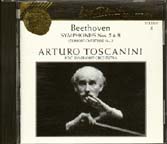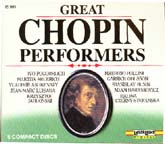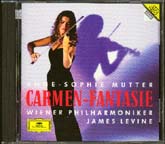Would you like to make this site your homepage? It's fast and easy...
Yes, Please make this my home page!

Classical CDs you must not miss
Here are some of my favorite classical CDs in my CD collection. Some of these CDs may seem prohibitively expensive, but these are just the list prices. You can easily find lower prices at Best Buy, at a Tower Records sale, or an online store. Go to the Tips for beginning (and perhaps experienced) CD collectors page for more tips on how to buy cheap CDs. (Sorry for having more or less abandoned this page. When I have more free time, I will start updating it again.)
 LABEL & CATALOG # RCA Gold Seal 60255-2-RG
LABEL & CATALOG # RCA Gold Seal 60255-2-RG
ALBUM TITLE Arturo Toscanini Collection Vol.4
CONTENTS Ludwig van Beethoven (1770-1827): Symphony #5 (rec.Mar 22, 1952), Symphony #8 (rec. Nov 10, 1952), Leonore Overture No.3, Op.72a (rec. Nov 4, 1939)
PERFORMERS Arturo Toscanini/NBC Symphony Orchestra
LIST PRICE US$ 10.97
COMMENTS The Leonore Overture No.3 recorded in 1939 is one of the most incredible recording in my whole collection (I am in fact tempted to say "the entire history of the gramophone"). I have two Toscanini recordings of this fantastic overture, the other one being recorded on June 1st, 1945, also with the NBC and is found in Vol.45 of the Toscanini Collection on RCA Gold Seal. The 1939 one is much better. The 1945 one may be technically more perfect and has a little more grandeur, and the acoustics is not as dry, but it is comparatively pedestrian. The 1939 recording is incomparable in its virtuosity and visceral excitement. It is visceral because you can feel the strong responses the playing triggers in your viscera. The great conductor and his great orchestra's fire was used in the best manner.
The interplay between the violins and the flute at 2:02 to 2:22 is remarkable. The violins are intentionally a little more rushed than the flute, an ingenious, magical trick of Toscanini's. Compare the entrance of the theme at 3:35 of this recording with the same spot in the 1945 recording, and the difference between the two versions will be obvious: The 1945 performance used a long, smooth melodic line, and is more plain, whereas the 1939 performance is more lively and dramatic and has more kick. The part that starts at 5:48 and ends at 6:53 is a wonderful part of this overture, and the great conductor was more successful in this part than anyone else. From 5:48 to 6:34, the same material is played over and over again, which makes the listener more anxious to hear the ravishing phrase played by the strings at 6:34 to 6:38. In this ravishing phrase, Toscanini squeezed the last bit of emotion out of the string players, and the effect is truly orgasmic! But this orgasm doesn't come singly; it happens again at 6:50 to 6:53, and this time Toscanini made it even more provocative. Listen to the violins' vibrato! The treatment of this part in the other recording is far more plain and thus disappointing. The more peaceful section starting at 7:13 gives the listener a resting period, important after the climactic tensions in the previous section, serving a similar function as the slow movement of a symphony. Then tension begins to build up again at 11:34, as more and more string players join the dramatic crescendo, beginning with the first violinists, followed by the second violinists, then the violists, and then the cellists and double bass players, and finally the whole orchestra. Beethoven had a really clever idea here. After the violists have joined, he added an extra "C" in the scales, and therefore the playing appears to slow down, creating an exciting effect. The virtuosity of the string players in this part is unreal. Listen to their clarity and precision. The rest of the overture is electrifying. I like the fast tempo that he used. At 12:04 to 12:15, the string players accompanied the brass instruments with amazing virtuosity. Then comes the most amazing section of all, from 12:15 to 12:28. They played these convulsive, syncopated notes marvelously. This part never fails to make me laugh, because it is so incredibly amazing! I also like the explosion of the brass instruments in the chord at 12:43. The piece ends with Toscanini/NBC's characteristic short, violent and perfectly synchronized chords.
The 5th and 8th symphonies on this CD are far less impressive and I will not discuss them.
 LABEL & CATALOG # Laserlight, 15-961
LABEL & CATALOG # Laserlight, 15-961
ALBUM TITLE Great Chopin Performers
CONTENTS Frederic Chopin (1810-1849): Ballades Nos.1 & 2, Barcarolle Op.60, Etudes Op.10 Nos.1, 5, 8, 10, 12, Op.25 Nos.6, 10, Impromptus Nos.3 & 4, Mazurkas Op.24 Nos.1-4, Op.30 Nos.1-4, Op.50 No.3, Op.59 Nos.1-3, Nocturnes Op.9 No.3, Op.37 No.2, Op.48 No.1, Op.55 No.2, Piano Concertos Nos.1 & 2, Piano Sonatas Nos.2 & 3, Polonaises Nos.3, 4, 5, 6, 7, Preludes Op.28 Nos.13-18 & 21-24, Op.45, Scherzos Nos.1, 2 & 3, Waltzes Op.18 No.1, Op.34 No.1, Op.64 No.1
PERFORMERS Martha Argerich, Adam Harasiewicz, Ivo Pogorelich, Garrick Ohlsson, Stanislav Bunin, Vladimir Ashkenazy, Krzystof Jablonski, Halina Czerny-Stefanska, Maurizio Pollini, Yuval Fichman, Kemal Gekic, Jean-Marc Luisada, Jan Ekier, Louis Kentner, Dang Thai Son, Witold Rowicki(conductor), Kazimierz Kord (conductor), National Philharmonic Orchestra
NUMBER OF DISCS 5
LIST PRICE US$ 20.97
COMMENTS This set should be in every household. Just look at the roster of pianists. It looks like a Who's Who of pianists over the last 40 years. And see how cheap it is! If your local store doesn't have it, ask them to order it for you! It is a great set because you can compare the different styles of so many famous Chopin players. From the wild impetus of Argerich to the authoritative perfection of Pollini and the unconventional interpretation of Pogorelich, you hear them all here. Also, most of the recordings were made live from the actual Chopin competitions. They are, unlike studio recordings, unedited, and you can be assured that what you hear is the "real thing". Some of my favorites in this set include Argerich's Etude Op.10 No.1 (where we can find Argerich's raw energy used in the best way), the coda of Harasiewicz's Ballade No.1 (few can play it with as much technical ease), Pogorelich's Sonata No.2 (played with a lot of drive, and contrasts in tempo, volume and colors are done very well) and Prelude Op.28 No.23 (he uses a true delicatissimo to produce a dream-like atmosphere), Ohlsson's Sonata No.3 (played with genuine feeling and a grand style), and Pollini's Polonaise No.5 (at first it sounded dry, but the more I listen to it the more I like it; his technique is astonishingly perfect, ranking with those of Hofmann, Michelangeli, and Josef Lhevinne). Listening to the Mazurkas played by Luisada, Gekic, and Pogorelich has again convinced me how difficult these mazurkas are musically. The mazurkas are Rubinstein's and Friedman's. Even so, Pollini has managed to overcome this big hurdle quite easily (listen to his Op.50 No.3). It's not a surprise to me, because Pollini is always "perfect"! Also interesting are Ashkenazy's Polonaise No.6 and Etude Op.25 No.6, which he played so fast but so easily! My advice is: Go get this invaluable set TODAY!
 LABEL & CATALOG # Deutsche Grammophon, 437 544-2
LABEL & CATALOG # Deutsche Grammophon, 437 544-2
ALBUM TITLE Carmen Fantasie
CONTENTS (album rec. Nov 1992) Pablo de Sarasate (1844-1908): Zigeunerweisen, Op.20, Carmen Fantasie, Op.25; Henryk Wieneawski (1835-1880): Legende in G minor, Opo.17; Giuseppe Tartini (1692-1770): Sonata in G minor "Devil's Trill"; Maurice Ravel (1875-1937): Tzigane; Jules Massenet (1842-1912): Meditation; Gabriel Faure (1845-1924): Berceuse in D, Op.16
PERFORMERS Anne-Sophie Mutter/Wiener Philharmoniker/James Levine
LIST PRICE US$ 16.97
COMMENTS This is certainly my favorite violin CD. Miss Mutter's playing is always deeply felt, and has the most diverse styles and tone colors. Sublety is the last word one would associate her playing with. Everything is explicitly and dramatically done. When a more straightforward style is desired, for instance in the Beethoven sonatas, her performance can sound exaggerated, but it is perfect for the showpieces on this CD. While every piece is superbly played, the Sarasate Carmen Fantasy is the most impressive recording on the disc. It is by far the best version I have heard (and I have heard many!). She successfully captures Carmen's flirtish character. One hears a wice spectrum of emotions. Other violinists focus on the technical side of the piece, but she knows that it has much more than that, and is capable of bringing out the meaning of the music with breathtaking virtuosity.

Last Update: December 4, 1999

 LABEL & CATALOG # RCA Gold Seal 60255-2-RG
LABEL & CATALOG # RCA Gold Seal 60255-2-RG LABEL & CATALOG # Laserlight, 15-961
LABEL & CATALOG # Laserlight, 15-961 LABEL & CATALOG # Deutsche Grammophon, 437 544-2
LABEL & CATALOG # Deutsche Grammophon, 437 544-2